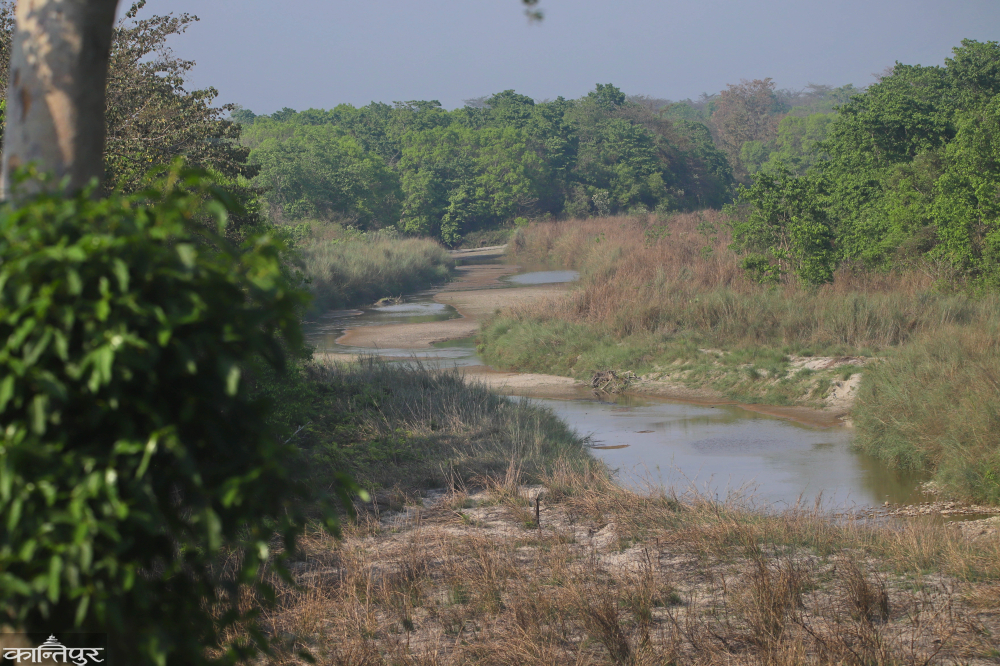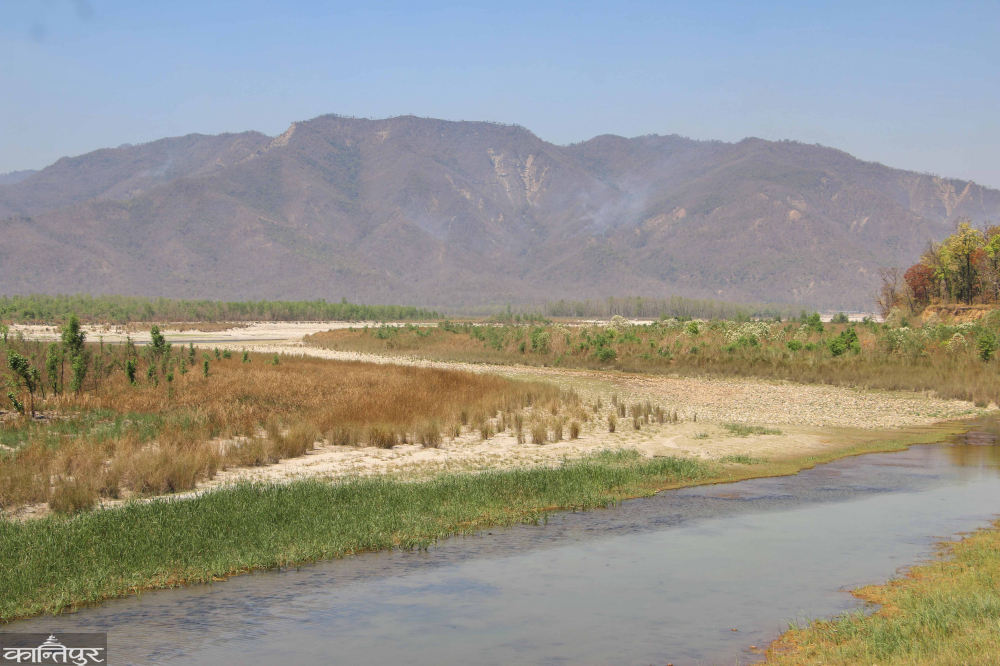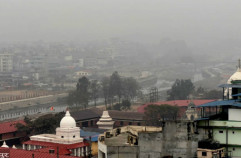Rivers dry up, wildlife to India to quench thirst
We use Google Cloud Translation Services. Google requires we provide the following disclaimer relating to use of this service:
This service may contain translations powered by Google. Google disclaims all warranties related to the translations, expressed or implied, including any warranties of accuracy, reliability, and any implied warranties of merchantability, fitness for a particular purpose, and noninfringement.


Khauraha river used to flow through the headquarters of Bardiya Park located in Thakurbaba Municipality-9. Khauraha River, which becomes a big river in rainy season, was difficult to cross even in winter. Two children were fishing in the same river on Monday morning. The water level was only up to their gills. The river has almost turned into a river. Locals say that Khauraha River has been drying up in winter for the past few years.


"Earlier, you could swim when it was hot," said local Rajan Chaudhary, "Earlier there was a river, now there is no river." According to him, not only Khauraha, but now all the canals flowing through the village through Thakur are dry. Until three/four years ago, there was water in the river even in winter. Common people used to swim there even when it was hot. "All the canals that carry water in Karnali are dry," he said.
Most of the wards of Thakurbaba Municipality-9 and the neighboring Madhuvan Municipality have been using water from the Karnali River as irrigation. After the water dried up in Geruwa Bhangalo, which flows eastward from Chisapani in Karnali, it affected irrigation. Residents who used to irrigate with river water are now dependent on tubewells and boreholes. 'How long will the water come from under the ground?' Rajan said, 'After the original source dries up, this water will also become stagnant and the problem will become worse.' Tourists have increased because tigers can be easily seen at this time. The tourist guides are there from morning till evening to show the wild animals including tigers to the guests through jeep safari. Previously, wild animals including tigers were seen drinking water and swimming in Gerua from here. On the eastern side of Geruwa, one could sit on the higher part and observe the activities of wild animals. Even last year dolphins could be seen in Gerua. Last Sunday, guide Anu Chaudhary took some tourists to a tented camp in the park. Even after waiting for about an hour on the bank of the Eastern Bhangalo Geruwa of Karnali, apart from the tiger, other wild animals were not seen much.
'Earlier there was enough water in Geruwa and even wild animals used to come to drink water and swim, now there is no water even up to the knees. Why are dolphins swimming?,' Choudhary said, 'Now it is hard to believe that there was once a Geruwa river here.' Water is not visible far from the camp. Still, tourists are arriving. "Tourists who have seen the big river before express their sadness at the current situation," he said, "Fish have disappeared since there is no water, wild animals have also disappeared, what will we show the guests now?" A little south of Chisapani, the two Bhangalas of Karnali separate. Bhangalo on the west side flows through Tikapur in Kailali. The Bhangalo on the east side flows through the boundary of Geruwa Park. A number of bhangalas formed from the separation of ocher flow through the park. Chief among them is Khauraha. After the ocher has dried up, the bhangras inside the park are also dry.

To avoid the water crisis for wildlife, organizations working in the park and conservation sector have built around 200 artificial ponds. However, they are not enough to swim large wild animals. Ajit Tumbahangfe, head of Nature Conservation Fund, Bardia, said, "Rhinoceros enjoy drinking water, for that they need a natural source of water." According to him, the main habitat of the rhinos is the Rhino Machan to Tinkune, Hattisar and Khauraha areas of the park. There was a problem after the water dried up. He said that due to lack of water, there has been an increase in the movement of wild animals to India through Kothiaghat under the Khata Biological Route. Tumbahangfe said that after the main source of water within the park dried up, biodiversity was wiped out.
'Until 2056/57, 10/15 dolphins used to jump at one time in Geruwa, now they have stopped. After the river dried up, agriculture was also affected, many effects were seen,' he said, there has been a water problem in the park for 6/7 years. Due to the excavation of gravel and sand, the gap towards Kailali was getting deeper. As gravel-sand piled up towards Geruwa, a mound was formed. He said that a lot of water started flowing towards Kailali and a natural dam was formed in Geruwa estuary with piles of gravel and sand.
Ramesh Kumar Thapa, the former Chief Conservation Officer of Bardia National Park, said that until 2040, water flowed equally in East and West Bhangalo of Karnali. The then District Panchayat excavated gravel and sand from Kothiyaghat for the construction of dams and bridges in Girijapuri, India. Due to the mining, the flood deepened during the rains. According to him, the flood that occurred at that time destroyed 6/700 bighas of Geruwa Rural Municipality. After being deep, for a long time Gerua was the main source of Karnali. A boat was needed to cross Gerua. A pontoon bridge was installed at Kothiaghat in winter to connect 11 villages of old Rajapur.
'Now the water has dried up and it is possible to walk,' Thapa said, 'Recently extensive excavations took place on the west side of Karnali, as a result of which a lot of water started flowing there, only gravel-sand was piled up on Geruwa's side.' He said that it is removed and brought water in winter. According to him, Geruwa springs were cleaned in Kattik, Pus and Chait every winter to increase the water.
Ashok Ram, chief conservation officer of Bardia Park, said that the main source of water in the park is the Karnali (geruwa) river. He said that because there is no water in Gerua now, it is a dire situation for wild animals. The Gerua Coastal Zone is a prime habitat for wildlife. He said that due to lack of water here, wild animals are moving to India through the biological route. 80 cusecs of water from Karnali river goes to Ranijamra irrigation project and in winter Karnali has only 200 cusecs of water, so it has become dry. Currently, there is no water in 6/7 of the Bhangals inside the park, and there is also a problem in irrigation. Last October, the water was returned by digging gravel-sand. Then the water was returned to Pus too.
'Now we have to deepen it again,' he said, 'This time, it became dry after not being able to open it in spring.' "The Irrigation Division office has awarded the contract," he said, "since we cannot work directly in the park area, we have sent it to the ministry for the mandate."


 २७.१२°C काठमाडौं
२७.१२°C काठमाडौं

















